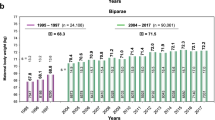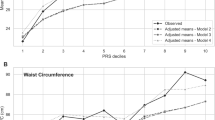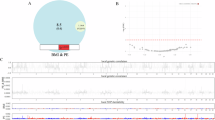Abstract
Objective
Obesity in pregnancy increases risk of preterm birth (PTB), a leading cause of infant mortality and morbidity. The heritability of obesity suggests associations of grandmaternal obesity with grandoffspring outcomes, but a potential effect on PTB has not been interrogated. We studied whether grandmaternal (F0 generation) body mass index (BMI) in early pregnancy was related to grandoffspring (F2 generation) PTB risk by type, and to maternal (F1 generation) preeclampsia risk.
Methods
Among 315,240 singleton live-born infants from a countrywide three-generation Swedish cohort, we compared risks of spontaneous and medically indicated PTB, defined as gestational age <37 completed gestation weeks, between categories of maternal grandmaternal BMI in early pregnancy. We also interrogated associations of grandmaternal BMI categories with risk of maternal preeclampsia, a major cause of medically indicated PTB. We assessed whether the associations were mediated through consequences of obesity. In a subset, we examined associations with paternal grandmaternal BMI. To address unmeasured confounding by shared familial factors, we assessed the associations of parental full sisters’ BMI with PTB.
Results
Maternal grandmaternal obesity (BMI ≥ 30.0) was related to increased risks of grandoffspring medically indicated PTB and maternal preeclampsia, compared with normal BMI. Adjusted hazard and risk ratios (95% confidence intervals) were, respectively, 1.54 (1.28, 1.86) and 1.32 (1.16, 1.49). Maternal sisters’ BMI was unrelated to PTB or preeclampsia risks. Maternal obesity or preeclampsia mediated most (85%) of the maternal grandmaternal obesity-grandoffspring medically indicated PTB association, whereas the association with maternal preeclampsia was primarily mediated (61%) through maternal obesity. There were no associations with spontaneous PTB. Paternal grandmaternal obesity was unrelated to grandoffspring’s PTB risk.
Conclusion
Medically indicated PTB in grandoffspring is associated with maternal grandmaternal obesity.
This is a preview of subscription content, access via your institution
Access options
Subscribe to this journal
Receive 12 print issues and online access
$259.00 per year
only $21.58 per issue
Buy this article
- Purchase on SpringerLink
- Instant access to full article PDF
Prices may be subject to local taxes which are calculated during checkout
Similar content being viewed by others
Data availability
The data that support the findings of this study are available from the Swedish National Board of Health and Welfare and Statistics Sweden but restrictions apply to the availability of these data, which were used under license for the current study, and so are not publicly available.
References
Perin J, Mulick A, Yeung D, Villavicencio F, Lopez G, Strong KL, et al. Global, regional, and national causes of under-5 mortality in 2000-19: an updated systematic analysis with implications for the Sustainable Development Goals. Lancet Child Adolesc Health. 2022;6:106–15.
Manuck TA, Rice MM, Bailit JL, Grobman WA, Reddy UM, Wapner RJ, et al. Preterm neonatal morbidity and mortality by gestational age: a contemporary cohort. Am J Obstet Gynecol. 2016;215:103.e1–e14.
Mitha A, Chen R, Razaz N, Johansson S, Stephansson O, Altman M, et al. Neurological development in children born moderately or late preterm: national cohort study. BMJ. 2024;384:e075630.
Crump C. An overview of adult health outcomes after preterm birth. Early Hum Dev. 2020;150:105187.
Ohuma EO, Moller AB, Bradley E, Chakwera S, Hussain-Alkhateeb L, Lewin A, et al. National, regional, and global estimates of preterm birth in 2020, with trends from 2010: a systematic analysis. Lancet. 2023;402:1261–71.
Cnattingius S, Villamor E, Johansson S, Edstedt Bonamy AK, Persson M, Wikström AK, et al. Maternal obesity and risk of preterm delivery. JAMA. 2013;309:2362–70.
Kurz CF, Konig AN. The causal influence of maternal obesity on preterm birth. Lancet Diabetes Endocrinol. 2020;8:101–3.
Villamor E, Cnattingius S. Interpregnancy weight change and risk of preterm delivery. Obesity. 2016;24:727–34.
Yang J, Bakshi A, Zhu Z, Hemani G, Vinkhuyzen AA, Lee SH, et al. Genetic variance estimation with imputed variants finds negligible missing heritability for human height and body mass index. Nat Genet. 2015;47:1114–20.
Villamor E, Cnattingius S. Grandmaternal body mass index in early pregnancy and risk of infant mortality in grandoffspring: a population-based multigeneration cohort study. Am J Clin Nutr. 2024;120:1156–64.
Goldenberg RL, Culhane JF, Iams JD, Romero R. Epidemiology and causes of preterm birth. Lancet. 2008;371:75–84.
Cnattingius S, Kallen K, Sandstrom A, Rydberg H, Mansson H, Stephansson O, et al. The Swedish medical birth register during five decades: documentation of the content and quality of the register. Eur J Epidemiol. 2023;38:109–20.
Ludvigsson JF, Otterblad-Olausson P, Pettersson BU, Ekbom A. The Swedish personal identity number: possibilities and pitfalls in healthcare and medical research. Eur J Epidemiol. 2009;24:659–67.
Ludvigsson JF, Almqvist C, Bonamy AK, Ljung R, Michaelsson K, Neovius M, et al. Registers of the Swedish total population and their use in medical research. Eur J Epidemiol. 2016;31:125–36.
Statistics Sweden. Evaluation of the Swedish Register of Education. Statistics Sweden: Örebro, Sweden; 2006.
Ekbom A. The Swedish Multi-generation Register. Methods Mol Biol. 2011;675:215–20.
Villamor E, Bosch RJ. Optimal treatment of replicate measurements in anthropometric studies. Ann Hum Biol. 2015;42:507–10.
World Health Organization. Obesity: preventing and managing the global epidemic. Report of a WHO consultation. World Health Organization Technical Report Series. World Health Organization: Geneva, Switzerland; 2000;894:i-xii, 1–253.
Tucker J, McGuire W. Epidemiology of preterm birth. BMJ. 2004;329:675–8.
George L, Granath F, Johansson AL, Cnattingius S. Self-reported nicotine exposure and plasma levels of cotinine in early and late pregnancy. Acta Obstet Gynecol Scand. 2006;85:1331–7.
Marsal K, Persson PH, Larsen T, Lilja H, Selbing A, Sultan B. Intrauterine growth curves based on ultrasonically estimated foetal weights. Acta Paediatr. 1996;85:843–8.
Ananth CV, Vintzileos AM. Maternal-fetal conditions necessitating a medical intervention resulting in preterm birth. Am J Obstet Gynecol. 2006;195:1557–63.
Schaefer JL. Analysis of incomplete multivariable data. 1st ed. Boca Raton: Chapman and Hall/CRC; 1997.
Rubin DB. Multiple imputation for nonresponse in surveys. New York, NY: John Wiley & Sons; 1987.
Valeri L, Vanderweele TJ. Mediation analysis allowing for exposure-mediator interactions and causal interpretation: theoretical assumptions and implementation with SAS and SPSS macros. Psychol Methods. 2013;18:137–50.
Villamor E, Cnattingius S. Interpregnancy weight change and risk of adverse pregnancy outcomes: a population-based study. Lancet. 2006;368:1164–70.
Skjaerven R, Vatten LJ, Wilcox AJ, Ronning T, Irgens LM, Lie RT. Recurrence of pre-eclampsia across generations: exploring fetal and maternal genetic components in a population based cohort. BMJ. 2005;331:877.
Skowronski AA, Leibel RL, LeDuc CA. Neurodevelopmental programming of adiposity: contributions to obesity risk. Endocr Rev. 2024;45:253–80.
Hemmingsson E, Nowicka P, Ulijaszek S, Sorensen TIA. The social origins of obesity within and across generations. Obes Rev. 2023;24:e13514.
Thompson AL. Intergenerational impact of maternal obesity and postnatal feeding practices on pediatric obesity. Nutr Rev. 2013;71:S55–61.
Acknowledgements
This study was supported by the Eunice Kennedy Shriver National Institute of Child Health & Human Development (HD106203).
Author information
Authors and Affiliations
Contributions
EV obtained funding, analyzed the data, wrote the first draft of the manuscript, and has primary responsibility for the final content. SC provided essential materials including access to the data, contributed to the study design, and aided in the interpretation of findings in the local context. Both authors read and approved the final manuscript.
Corresponding author
Ethics declarations
Competing interests
The authors declare no competing interests.
Ethics approval and consent to participate
Approval was obtained from the Regional Ethical Review Board in Stockholm, Sweden (No. 2018/5:2). Since all data were anonymous, informed consent was not required. All methods were performed in accordance with the relevant guidelines and regulations.
Additional information
Publisher’s note Springer Nature remains neutral with regard to jurisdictional claims in published maps and institutional affiliations.
Supplementary information
Rights and permissions
Springer Nature or its licensor (e.g. a society or other partner) holds exclusive rights to this article under a publishing agreement with the author(s) or other rightsholder(s); author self-archiving of the accepted manuscript version of this article is solely governed by the terms of such publishing agreement and applicable law.
About this article
Cite this article
Villamor, E., Cnattingius, S. Grandmaternal obesity in early pregnancy and risk of grandoffspring preterm birth: a nationwide three-generation study. Int J Obes 49, 942–948 (2025). https://doi.org/10.1038/s41366-025-01731-7
Received:
Revised:
Accepted:
Published:
Issue date:
DOI: https://doi.org/10.1038/s41366-025-01731-7



